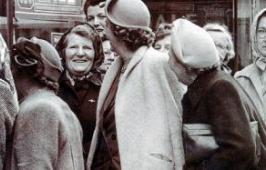Trade Theory
The aim of Trade Theory is to explain the existing patterns of trade, the impact on the domestic economy, and the type of public policies that should be introduced to increase a country's well-being. Neoclassical theories focus on the optimal repartition of production among countries in order to take advantage of each nation's availability of resources (such as labor or natural/physical capital). They conclude that all countries can gain by trade thanks to international specialization and a more efficient use of resources. Modern theories try to reinforce this result by relaxing the most stringent assumptions (such as perfect competition, no transaction cost or decreasing returns to scale), in order to explain why trade often occurs between countries with similar factor endowment and productivity levels, and why firms do offshoring.
Related posts
|
From theory to application In a recent paper, we investigate the conditions under which adaptive learning | READ MORE ... |
From theory to application In a large number of real-life markets agents exchange goods or services | READ MORE ... |
From theory to application Cooperation is a self-reinforcing behavior. The additional private information | READ MORE ... |
|
Article The estate division problem considers the issue of dividing an estate when the | READ MORE ... |
From theory to application The advances in FinTech are concomitant with the development of digital | READ MORE ... |
Article Competition between two-sided platforms is shaped by the possibility of | READ MORE ... |
|
Book Networks pervade social and economic life, and they play a prominent role in | READ MORE ... |
Working paper On many two-sided platforms, users on one side not only care about user | READ MORE ... |
Article In this paper, we extend the noncooperative analysis of multilateral oligopoly | READ MORE ... |
|
Article We study a variation of Hotelling’s location model in which consumers choose | READ MORE ... |
Article We design a laboratory experiment to investigate matching in a decentralized | READ MORE ... |
From theory to application . |
|
Working paper We study trading situations in which several principals on one side of
the | READ MORE ... |
Working paper This paper introduces a number of game-theoretic tools to model collusive | READ MORE ... |
Article We study Nash implementation by natural price–quantity mechanisms in pure | READ MORE ... |
|
Article We show the existence of a Cournot–Nash equilibrium for a mixed version of the | READ MORE ... |
Article We study random assignment economies with expected-utility agents, each of them | READ MORE ... |
Article We allocate agents to three kinds of hierarchical positions: top, medium, and | READ MORE ... |
|
Article Consider a society with a finite number of sectors (social issues or | READ MORE ... |
From theory to application If exchange of a good between a buyer and a seller generates a surplus, it is | READ MORE ... |
Article We analyze the two-stage games induced by competitive equilibrium rules for the | READ MORE ... |
|
Article We introduce within-group external effects in the two-sided singlehoming model | READ MORE ... |
Article We study contests with private information and identical contestants, where | READ MORE ... |
Working paper In this paper I investigate mutual insurance arrangements restricted on a | READ MORE ... |
|
Working paper We develop a product-differentiated model where the product space is a network | READ MORE ... |
Working paper We study the optimal entry fee in a symmetric private value first-price auction | READ MORE ... |
Working paper Just like soldiers crossing a bridge in sync can lead to a catastrophic failure | READ MORE ... |
|
Article We introduce, in the standard exchange economy model, market games in which | READ MORE ... |
Article Many salient rules to allocate private goods are not only strategy-proof, but | READ MORE ... |
Article With a laboratory experiment, we study the impact of buy-options and the | READ MORE ... |
|
Article We study a model in which heterogeneous agents first form a trading network | READ MORE ... |
Working paper We consider a situation in which agents have mutual claims on each other, | READ MORE ... |
Working paper The purpose of this paper is to analyze the effects on the Italian directorship | READ MORE ... |
|
Working paper This paper studies how the possibility for firms to sign collusive agreements ( | READ MORE ... |
Article In a bilateral oligopoly, with large traders, represented as atoms, and small | READ MORE ... |
From theory to application One of the most common online activities is search. Large companies, such as | READ MORE ... |
|
Book "A beautiful dozen. Twelve papers presented in 20 years of meetings of the | READ MORE ... |
From theory to application The growth of the Internet and assorted technologies has made it possible to | READ MORE ... |
From theory to application How do agents form new connections? Some introspection should convince most | READ MORE ... |
|
Working paper What determines which inputs are initially considered and eventually adopted in | READ MORE ... |
Working paper We investigate the role of networks of military alliances in preventing or | READ MORE ... |
Article In a standard adverse selection world, asymmetric information about product | READ MORE ... |
|
From theory to application Life in developing countries is subject to much higher risk than in | READ MORE ... |
Working paper Is the result that equilibrium trading outcomes are e cient in mar- kets | READ MORE ... |
Working paper We consider a market where firms hire workers to run their projects and such | READ MORE ... |
|
Working paper This paper identi es a new terms-of-trade externality that is exercised through | READ MORE ... |
Working paper This paper investigates the determinants of the shape of regional trade | READ MORE ... |
Working paper This paper analyzes the role of retaliation in trade agreements. It shows that | READ MORE ... |
|
Working paper he paper aims at understanding the structural features of the bargaining | READ MORE ... |
Working paper This paper uses an endogenous merger formation approach in a concentrated | READ MORE ... |
Working paper This paper argues that free trade agreements (FTAs) are regional because, in | READ MORE ... |
|
Working paper In this paper, we assume that redistribution modifies the community structure | READ MORE ... |
Working paper We consider a model with two countries, two commodities and production factors | READ MORE ... |
Working paper The purpose of this paper is twofold. First, we present a new model of | READ MORE ... |
|
Working paper When trade involves differentiated products, preferential ties to a group | READ MORE ... |
Working paper Recent regional initiatives have been addressed from a Vinerian perspective of | READ MORE ... |
Working paper This paper examines the impact of the emergence of regional blocs (customs | READ MORE ... |
|
Article This paper develops a two country endogenous growth model with accumulation of | READ MORE ... |










